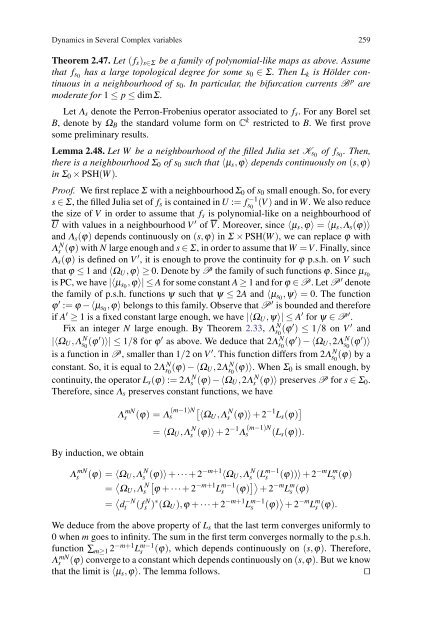Discrete Holomorphic Local Dynamical Systems
Discrete Holomorphic Local Dynamical Systems
Discrete Holomorphic Local Dynamical Systems
You also want an ePaper? Increase the reach of your titles
YUMPU automatically turns print PDFs into web optimized ePapers that Google loves.
Dynamics in Several Complex variables 259<br />
Theorem 2.47. Let ( fs)s∈Σ be a family of polynomial-like maps as above. Assume<br />
that fs0 has a large topological degree for some s0 ∈ Σ. ThenLk is Hölder continuous<br />
in a neighbourhood of s0. In particular, the bifurcation currents B p are<br />
moderate for 1 ≤ p ≤ dimΣ.<br />
Let Λs denote the Perron-Frobenius operator associated to fs. For any Borel set<br />
B, denote by ΩB the standard volume form on C k restricted to B. We first prove<br />
some preliminary results.<br />
Lemma 2.48. Let W be a neighbourhood of the filled Julia set Ks0 of fs0 . Then,<br />
there is a neighbourhood Σ0 of s0 such that 〈μs,ϕ〉 depends continuously on (s,ϕ)<br />
in Σ0 × PSH(W ).<br />
Proof. We first replace Σ with a neighbourhood Σ0 of s0 small enough. So, for every<br />
s ∈ Σ, the filled Julia set of fs is contained in U := f −1<br />
s0 (V ) and in W. We also reduce<br />
the size of V in order to assume that fs is polynomial-like on a neighbourhood of<br />
U with values in a neighbourhood V ′ of V. Moreover, since 〈μs,ϕ〉 = 〈μs,Λs(ϕ)〉<br />
and Λs(ϕ) depends continuously on (s,ϕ) in Σ × PSH(W ), we can replace ϕ with<br />
Λ N s (ϕ) with N large enough and s ∈ Σ, in order to assume that W = V. Finally, since<br />
Λs(ϕ) is defined on V ′ , it is enough to prove the continuity for ϕ p.s.h. on V such<br />
that ϕ ≤ 1and〈ΩU,ϕ〉≥0. Denote by P the family of such functions ϕ.Sinceμs0<br />
is PC, we have |〈μs0 ,ϕ〉| ≤ A for some constant A ≥ 1andforϕ∈P.LetP′ denote<br />
the family of p.s.h. functions ψ such that ψ ≤ 2A and 〈μs0 ,ψ〉 = 0. The function<br />
ϕ ′ := ϕ −〈μs0 ,ϕ〉 belongs to this family. Observe that P′ is bounded and therefore<br />
if A ′ ≥ 1 is a fixed constant large enough, we have |〈ΩU,ψ〉| ≤ A ′ for ψ ∈ P ′ .<br />
FixanintegerNlargeenough. By Theorem 2.33, Λ N s0 (ϕ′ ) ≤ 1/8 onV ′ and<br />
|〈ΩU,Λ N s0 (ϕ′ )〉| ≤ 1/8 forϕ ′ as above. We deduce that 2Λ N s0 (ϕ′ ) −〈ΩU,2Λ N s0 (ϕ′ )〉<br />
is a function in P, smaller than 1/2onV ′ . This function differs from 2Λ N s0 (ϕ) by a<br />
constant. So, it is equal to 2Λ N s0 (ϕ) −〈ΩU,2Λ N s0 (ϕ)〉. WhenΣ0issmall enough, by<br />
continuity, the operator Ls(ϕ) := 2Λ N s (ϕ)−〈ΩU ,2Λ N s (ϕ)〉 preserves P for s ∈ Σ0.<br />
Therefore, since Λs preserves constant functions, we have<br />
�<br />
〈ΩU ,Λ N s (ϕ)〉 + 2 −1 Ls(ϕ) �<br />
By induction, we obtain<br />
Λ mN<br />
s (ϕ) =Λ (m−1)N<br />
s<br />
= 〈ΩU,Λ N s (ϕ)〉 + 2 −1 Λ (m−1)N<br />
s (Ls(ϕ)).<br />
Λ mN<br />
s (ϕ) =〈ΩU,Λ N s (ϕ)〉 + ···+ 2−m+1 〈ΩU,Λ N s (Lm−1 s<br />
= � ΩU,Λ N� −m+1 m−1<br />
s ϕ + ···+ 2 Ls (ϕ) �� + 2 −m L m s (ϕ)<br />
(ϕ))〉 + 2 −m L m s (ϕ)<br />
= � d −N<br />
t ( f N s )∗ (ΩU ),ϕ + ···+ 2 −m+1 L m−1<br />
s (ϕ) � + 2 −m L m s (ϕ).<br />
We deduce from the above property of Ls that the last term converges uniformly to<br />
0whenmgoes to infinity. The sum in the first term converges normally to the p.s.h.<br />
function ∑m≥1 2−m+1Lm−1 s (ϕ), which depends continuously on (s,ϕ). Therefore,<br />
Λ mN<br />
s (ϕ) converge to a constant which depends continuously on (s,ϕ). But we know<br />
that the limit is 〈μs,ϕ〉. The lemma follows. ⊓⊔



